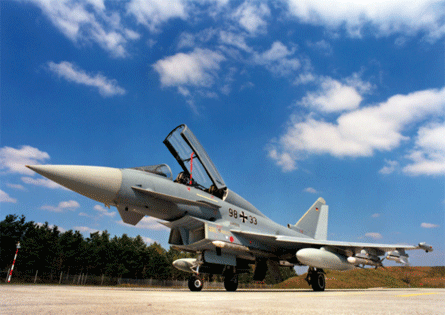The German air force is ready to police the nation's southern skies, with its newest fighter poised to provide air defence duties
Four years after receiving its first Eurofighter, the German air force is poised to provide full-time quick reaction alert duties using the type, and remains fully committed to fielding its planned fleet of 180 aircraft, says chief of staff Lt Gen Klaus-Peter Stieglitz.
Eurofighters assigned to the Fighter Wing 74 (FW74) at Neuburg/Donau air base near Munich have been conducting quick reaction alert tasks since early January on a shared basis with McDonnell Douglas F-4F Phantom fighters, but in June will take on the responsibility of providing permanent air policing duties for southern Germany.
 |
|---|
©Geoffrey Lee/EurofighterGermany's Eurofighters will provide permanent quick reaction alert duties from June |
Germany in March received its 40th Eurofighter, with this the last of 156 to be manufactured for the nation and programme partners Italy, Spain and the UK under Tranche 1 production of the Typhoon. Two of its aircraft are assigned to industry to support ongoing development work, leaving an active fleet of 38.
GREAT ADVANCES
"We have flown about 7,000h with the Eurofighter, and have made great advances over the last four years," says Stieglitz. "We are getting on very well." The total represents around 20% of the more than 35,000h so far flown by the partner air forces and launch export operator Austria, which has now received five of its 15 Tranche 1 interceptors.
Training activities for Germany and Austria are performed at Rostock-Laage in northern Germany by FW73, which during March deployed three of its aircraft to participate in the first four-nation "Typhoon Meet". Conducted at Morón air base near Seville, Spain, the exercise involved 20 Eurofighters.
Germany will continue operations with its F-4s until around 2012-13, and retain 85 Panavia Tornados in the interdictor strike, reconnaissance and electronic combat/reconnaissance roles "beyond 2020", says Stieglitz. But the Eurofighter will form the backbone of the combat aircraft fleet for the coming decades.
"It is the most modern aircraft in Europe, with a wide variety of capabilities in terms of air-to-air and air-to-ground," says Stieglitz. "It means sensor fusion, information management and information connectivity for future coalition warfare. It's a major step for the Luftwaffe in transforming itself."
While the Tranche 1 Eurofighter will provide only air-to-air services, Stieglitz says Germany looks forward to using the type's multirole capabilities under an enhancement package to be introduced with Tranche 2 examples in 2011-12. This will incorporate new air-to-ground equipment such as a target designation pod and EGBU-16 laser-guided bombs.
"We are taking a step-by-step approach in going to a truly multirole combat aircraft," says Stieglitz. "This will take time, but it will come." Forty Tranche 2 aircraft are now in final assembly for the partner nations, with type acceptance work on the so-called Block 8 configuration taking place and deliveries scheduled to start later this year.
Proposals for the remaining 236 aircraft in the Eurofighter programme's 620-strong umbrella contract were submitted last December, with Tranche 3 capabilities to potentially include an active electronically scanned array radar, conformal fuel tanks for extended range, more powerful Eurojet EJ200 turbofan engines, enhanced computing capacity and provisions for software growth.
"We are in a dialogue with the customer, and the objective has not changed - to have something to sign by the end of 2008, or maybe early 2009," says the four-nation Eurofighter industry consortium, which declined to discuss the process further before the Berlin air show.
MULTIROLE CAPABILITY
Speaking to Flight International at the RUSI's Air Power conference in London in eary May, Stieglitz stressed the importance of the final production standard in meeting German air force requirements. "We are not talking about the Tranche 3 aircraft: we are talking about developing the full multirole capability," he says. "This has to be defined with industry and with the nations, but we are completely committed to 180 Eurofighters. There are no other priorities."
An experienced fighter pilot with over 3,500 flying hours on types including the Lockheed F-104 Starfighter, F-4 Phantom and RSK MiG-29, Stieglitz says: "The Eurofighter is the best aircraft in Europe, in terms of agility, growth potential, connectivity, communications and reliability."
 |
|---|
©Geoffrey Lee/EurofighterEurofighter availabilty and reliability is "better than 20 years agowith the Tornado" |
Future deliveries of the Eurofighter will be made to Germany's Fighter Bomber Wing 31 (FBW31) at Nörvenich, west of Cologne, with the currently Tornado-equipped unit to receive its first aircraft and begin conversion activities during 2009. A further two squadrons will also receive the type: FW71 and FBW33.
"The day we took over the Eurofighter, I asked my technicians to support the aircraft, and to try to work as long as they could do it themselves, because I wanted to have a high learning curve at the beginning," says Stieglitz. "Right now, the availability and reliability of the Eurofighter is better than what we had 20 years ago with the Tornado. This proves to me that this approach was a good solution."
Source: Flight International
















